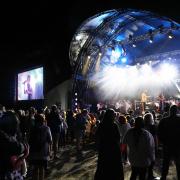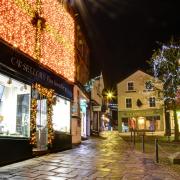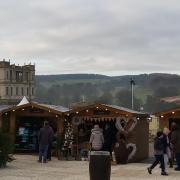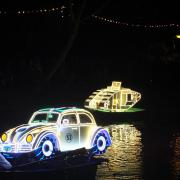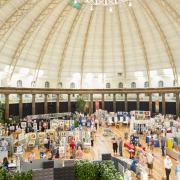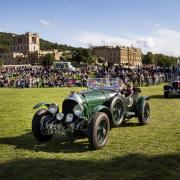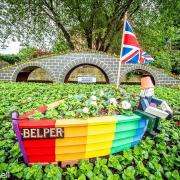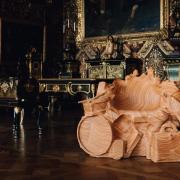Robert Falconer looks at the history of The Midland Railway and its unique link with Derby

This year has marked a momentous landmark in the history of Derby – the 175th anniversary of the arrival of the railway. This transformed Derby and established the foundations for its development into the centre of industry and technology that we know today.
In 1839 the North Midland Railway, Midland Counties Railway and Derby to Birmingham Railway set up workshops at the back of Derby station as railway lines started to spread across the country like a spider’s web. On 30th May 1839 the line from Derby to Nottingham was opened and the line to Birmingham followed on 5th August. The line north, through Chesterfield to Mosborough, near Rotherham, was opened on 11th May 1840.
These three companies merged to form the Midland Railway in 1844. The company created its coat of arms, which can still be seen at the front of Derby railway station, adopting a Wyvern – a mythical creature with a dragons head, two legs and a barbed tail – because it believed this was the emblem of the rulers of Mercia. It wasn’t until 1897 that the Railway Magazine pointed out the Wyvern had no links with Mercia.
The Midland Railway became one of the country’s prominent railway companies with lines throughout Derbyshire, up to Carlisle in the North (including the country’s highest station at Dent) and to the south with its London terminus at spectacular St Pancras. Designed by William Henry Barlow, St Pancras’s large, arched glass and metal roof and the distinctive clock tower of the Midland Grand Hotel attached to the station reinforced the Midland’s claim to be one of the most influential companies in the history of this country’s railways. Its impact is still felt today as it is the main point of departure for Europe. Travel writer Simon Calder has even declared it ‘The world’s most wonderful railway station.’

Despite its expansion the Midland kept its headquarters in Derby, making the town one of the most important centres for railway industry, alongside York, Crewe and Swindon. It was the only one of the old railways to own or share lines in England, Scotland, Wales and Ireland, becoming the third-largest railway undertaking in the British Isles (after the Great Western and the London & North Western), the largest coal haulier and biggest company to have its headquarters outside London. Once the Great Central Railway moved its headquarters to London in 1907 the Midland was the only company serving the capital not to have its headquarters there.
The Midland Railway was not the only railway company serving Derbyshire, but it did cover more of the county than any other. The railway reached Matlock in 1849, transforming the prosperity of the town and bringing tourism to nearby Matlock Bath, and in 1863 it reached Buxton.
The onset of the First World War put all the railways under state control and this remained the case until 1921. Under the government of David Lloyd George, the Railways Act 1921 – ‘The Grouping’ – was an attempt to stem the losses of 120 railway companies across the country, some of them quite small, by merging them into four major railway companies which became known the ‘Big Four’ and on 1st January 1923 The Midland Railway was merged into the London, Midland and Scottish Railway (LMS), making it the largest railway company in the UK. Derby was still a major centre, but the newly-created company’s headquarters became Euston House in London.
It was all change again during the Second World War when the country’s railway system was under great strain with extensive damage from bombing. The management of the railways was united under the direction of the Railway Executive Committee. After the War, the next step was the passing of the 1947 Transport Act, and on 1st January 1948 the railways were nationalised and became ‘British Railways’. There were still financial problems and during the 1960s the Beeching axe closed thousands of miles of track across the country, including many of Derbyshire’s railway lines. Between 1994 and 1997 British Railways was privatised.

For railway enthusiasts, The Midland Railway had an almost iconic significance. The idea to commemorate the role it had played first arose in 1969 with the suggestion of setting up a permanent working museum. The Midland Railway Project Group, a mainly voluntary work force, was established to support the idea. Artefacts from the Midland Railway, such as signalling, rolling stock and locomotives for restoration and preservation, were brought together and the closed line from Pye Bridge to Ambergate was chosen as an ideal site – although it could not be fully rebuilt because of the A38. The Midland Railway Trust finally re-opened the line on 22nd August 1981 and a lot of hard work by many dedicated volunteers has followed. One of the latest developments was the gala opening at Swanwick Junction this spring of a footbridge which had been created from scratch to span a three-platform Midland junction station. Trains have been operating throughout this year at the Midland Railway Centre and Derbyshire is fortunate also to have Peak Rail and the Ecclesbourne Valley Railway, allowing many visitors every year to take a journey on railway lines built by the Midland Railway.
This year’s 175th anniversary has been marked in a number of ways, with everything from private dinners to a public open day at East Midlands Trains’ Etches Park depot in September. The Roundhouse, one of the original Midland buildings that still exists and is now part of the Derby College campus, has held a number of events – a recent Derby Roundhouse Dinner was attended by some of the most influential figures in the UK rail industry. On 25th October a Civic Service will be held at Derby Cathedral to celebrate the contribution of the railways to our city and county with an address by Rt Hon Patrick McLoughlin MP, Secretary of State for Transport.
After a few uncertain years for the railway industry in Derby, the announcement earlier this year of a £1bn contract for Bombardier Transportation – the city and the country’s only surviving train maker – gave us all something to celebrate in this landmark year as we proudly acknowledge the role the railway industry has had in the making of our city. n
For further details go to www.derby175.co.uk.






